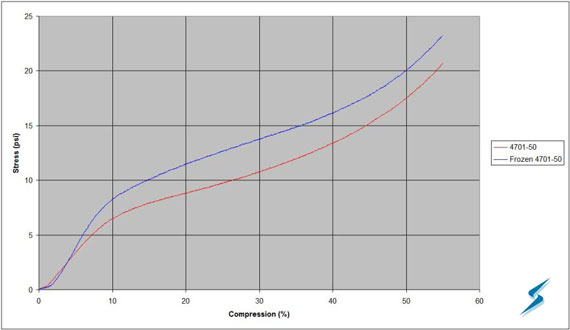Contact Stockwell Elastomerics
Request a quote or get more information.
Elastomeric gaskets and cushioning pads can be relatively sensitive to low temperatures. Temperatures listed on material datasheets don’t always translate into functional temperatures in an application. Low temperature testing for elastomeric gasket materials is usually limited to brittleness or cracking test. Expanded rubber products such as sponges and foams are usually tested under ASTM D 1056, solid elastomers are often tested under ASTM D 2137 (brittleness test).
Cold soak for 5 hours at the appropriate temperatures (per suffix shown below) and bend 180° around a mandrel. Inspect samples for any cracking and see if it is still pliable; no signs of cracking are allowed. If the material is not pliable or cracks, it’s considered unsuitable for applications at or below the test condition.
Cold flex tests offer the low temperature of material however in real world applications this typically doesn’t translate to a functional low temperature. This is very apparent with cushioning pad applications.
Example: Cushioning Pad, Handheld Device Cold Drop Test Ruggedized mobile device is cold soaked at -20°C then dropped from 48″ or 60″ and must function properly after the drop test. Internal components are often protected by an external rubber shell and cushioning pads inside the device. Urethane is often used for ambient applications, however at low temperatures urethane turns hard, losing its dampening properties. Even moderately low temperatures are enough to harden foam to a point where energy from a drop is transferred to sensitive electronics.

The curves above show a shift in compressive forces for a PORON® urethane foam that was cold soaked for 48hrs at 20°F. Click graph for larger chart.
As with all gasket and cushioning pad applications, environmental conditions should be considered in conjunction with the functional requirements of the device. Silicone is regularly specified for low temperature applications that require a gasket or pad to remain flexible and compliant. There are a wide range of silicone products to select from for specific applications such as; soft silicone sponges and foams, soft (low durometer) silicone sheets, custom molded solid silicone. Many of the commercially available silicone products are well suited for meeting MIL-STD-810 testing including low temperature, high temperature, UV resistance, salt fog and water sealing.
Some specifications and applications require even even lower temperatures. Stockwell Elastomerics now offers several different durometers and thicknesses of methyl phenyl silicone for extreme low temperature uses. Methyl phenyl silicones (PVMQ, PMQ) are formulated for these low temperature applications. A-A 59588 Class 1A is specific for low temperature resistance while Class 1B is specified for low temperature resistance and low compression set. In some cases, phenyl silicone can remain flexible at temperatures of -130F. ASTM D 2137 (as part of A-A 59588) is a pass/fail on impact brittle point of the materials, tested to -70C (-103F). More details available on the Elastomerics Blog.
Contact Us for further assistance with custom low temp gaskets and low temp gasket material.